
Anduze Planter flamed enamelled Tradition - 4 sizes
Anduze vase with traditional flamed glaze made in France according to tradition by TERRE FIGUIERE
This is an authentic Anduze pottery made of clay with a flamed glaze
Available in 4 sizes


Anduze vase with traditional flamed glaze made in France according to tradition by TERRE FIGUIERE
This is an authentic Anduze pottery made of clay with a flamed glaze
Available in 4 sizes

Green enamelled Anduze pottery, made in France by Terre Figuière.
An artisanal and authentic creation respecting the traditions and prestige of these original vases from the South of France.
Choose from several vase sizes.

Natural ceruse Anduze vase, authentic, made in France by Terre Figuière.
4 sizes are possible.

Anduze planter made in France respecting traditional methods by Terre Figuière
It is an Anduze authentic planter made of natural clay with a blue cerused finish.
For conditions of delivery, please see below.

This authentic Anduze enamelled vase is signed by Terre Figuière.
It is an artisanal and French creation, typical of the prestigious vases of the south of France.
Several sizes are possible.

Antique Patinated Anduze planter made in France respecting the manufacturing traditions by Terre Figuière
This is an authentic Anduze pottery made of clay with a old patina finish
For conditions of delivery, please see below

This Anduze vase is made in France by Terre Figuière.
It is a typical artisanal creation of prestigious vases from the south of France.
Several sizes are possible for these vases.

Anduze vase enamelled in honey colours. Made in France by Terre Figuière, this vase is an artisanal and authentic creation. Several sizes are possible.

The Anduze green cerused natural planter is made in the South of France by Terre Figuiere.
This is an artisanal pottery, made by a master potter.
For conditions of delivery, please see below.
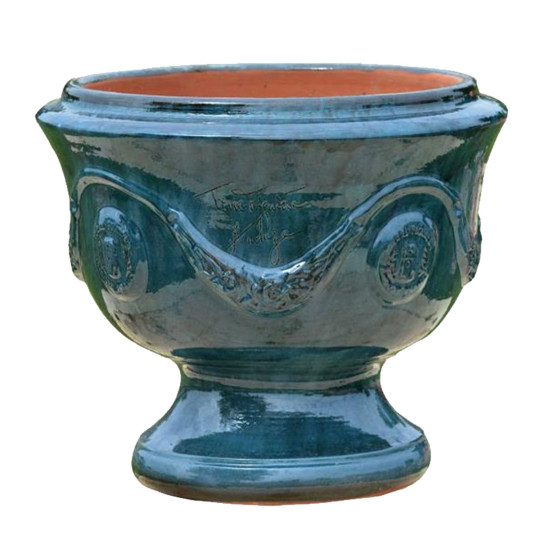
Anduze cup planter by Terre Figuière.
Made of enamelled clay, this planter is designed in the pure tradition of the garden pottery of the South of France.
For conditions of delivery, please see below.
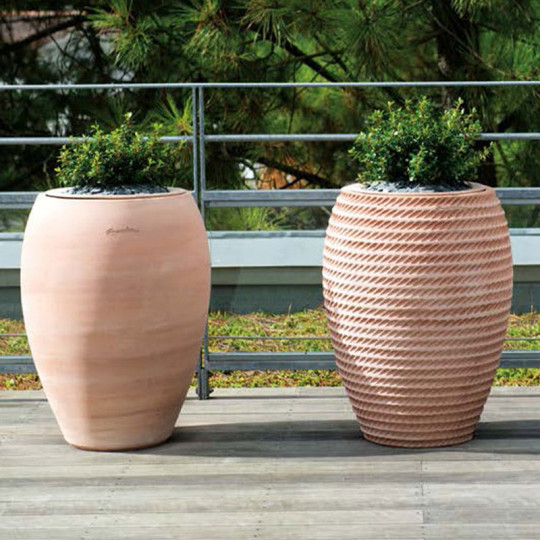
Contemporary jar, made in France by GOICOECHEA.
3 colours, 3 finishes and 2 sizes are available.
Please contact previously our customer service, if you want to order.

Contemporary vat jar made in France in an artisanal way and in terracotta, by Goicoechea.
3 colours, 3 finishes and 4 sizes.
Please contact previously our customer service, if you want to order.

High-end French pottery, this tube vase is made in France by Goicoechea.
10 colours, 3 finishes, 4 sizes.
Please contact previously our customer service, if you want to order.

This authentic Anduze vase is made in France by Terre Figuière.
This majestic vase is a timeless piece from French heritage and culture.
It is anthracite in color and comes in 4 sizes.
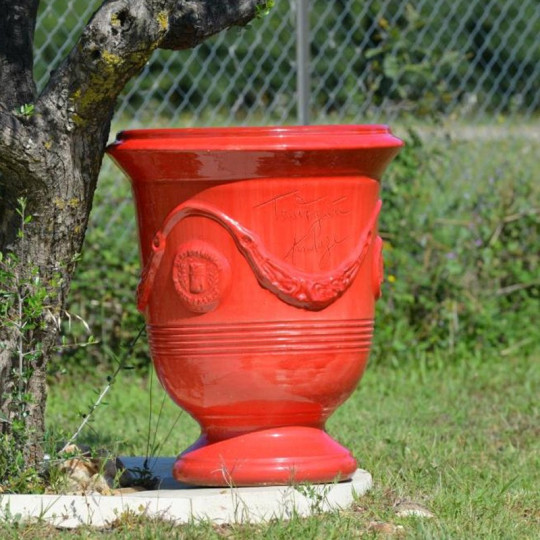
This authentic Anduze vase is signed by the manufacturer Terre Figuière.
It is made in France.
A handcrafted creation typical of prestigious vases from the south of France.
4 sizes are available.

Terre Figuière manufactures in France this superb Anduze vase enamelled in ivory.
An artisanal and authentic creation, typical and prestigious of the South of France.
You can choose from several sizes.

VENTRUE jar made in France by GOICOECHEA.
11 colors are available, each available in 3 finishes and 3 sizes.
Deposited model.
Please contact previously our customer service, if you want to order.

Terre Figuière manufactures in France, this natural and burgundy whitewashed Anduze vase.
Authentic, prestigious and made in the traditions of the South of France.

Fuseau vase/jar made in France by Goicoechea.
A true work of art, unique pieces, signed by the hand of the master potter.
10 colours, 3 finishes and 4 sizes.

Anduze Natural Cerused Cup Planter made in France in a traditional way by Terre Figuière.
It is an authentic Anduze terracotta pottery with a ceruze finish.

Enamelled red Anduze planter made in France with traditional methods by Terre Figuière
This is an authentic enamelled Anduze pottery.
For conditions of delivery, please see below.

The brown ceruse planter by Terre Figuière is manufactured with traditional methods.
This beautiful planter is a very nice model with an aesthetic which is specific to the famous French potteries of Anduze.
For conditions of delivery, please see below.

The Anduze planter cup old patina is a traditional creation by Terre Figuière.
This is an authentic pottery that has been manufactured respecting traditional methods.
For conditions of delivery, please see below.
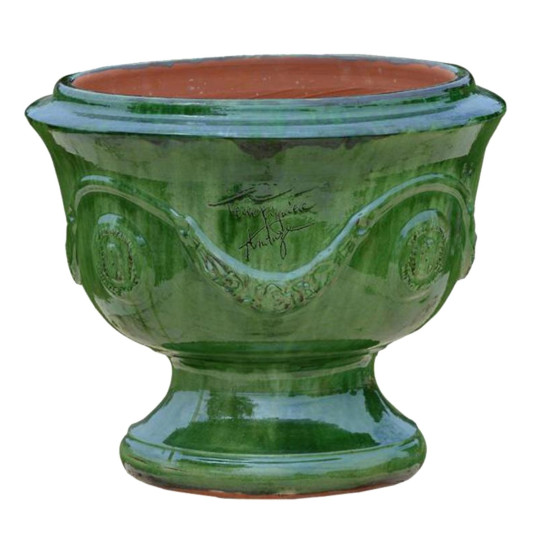
Anduze cup planter by Terre Figuière.
Made of enamelled clay, this planter is designed in the pure tradition of the garden pottery of the South of France.
For conditions of delivery, please see below.

The Anduze cup planter made of enamelled clay is a creation by Terre Figuière.
This planter is made in the respect of the pure tradition of garden pottery in the South of France.
For conditions of delivery, please see below.

Natural whitewashed Anduze vase and honey, authentic, made in France by Terre Figuière.
An original and typical creation of pottery from the South of France.
Several sizes are available.

This antique aged enamelled Anduze vase is signed by the manufacturer Terre Figuière.
A typical artisanal creation of prestigious vases from the south of France, which you can choose from several possible sizes.
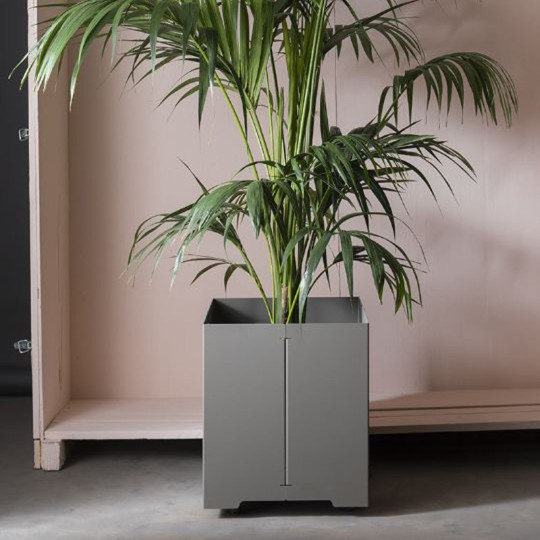
The CAPE planter is made in France by Matière Grise.
Collection of the same name - design by Luc Jozancy.
38 colors are available to you, in 3 shapes, in a version designed for outdoors.
Explore our collection of artisanal vases made in the south of France, available on our Francecorner website. Discover the timeless beauty of Anduze terracotta vases, orange pots, as well as jars and vats, all made with remarkable artisanal know-how.
Offering a variety of captivating colors, varying heights and unique dimensions, our vases will captivate your senses and beautify your interior and exterior spaces. Immerse yourself in the elegance of the South of France and add a touch of authenticity to your decor thanks to these exceptional creations made by workshops such as Terre Figuière, Goicoechea, Terre Albine. These vases represent French elegance and craftsmanship
While the terms "ceramics" and "pottery" are often used interchangeably, they actually refer to distinct types of manufacturing with unique characteristics. At francecorner.com, we offer a diverse range of products made in France, including both ceramic and pottery items, each with their own specificities.
Ceramics
Ceramics are a material made by firing clay at high temperatures in a kiln. This process creates durable, impact-resistant, and often waterproof pieces. Ceramic products, such as plates, cups, and carafes, can be glazed to add colorful and glossy finishes. Ceramic manufacturing techniques allow for a wide variety of shapes and designs, while ensuring superior quality and durability.
Pottery
Pottery, on the other hand, generally refers to objects made from clay fired at a lower temperature than ceramics, often without glaze or with a very simple glaze. Pottery pieces, such as pots and vases, often have a rougher texture and a less smooth finish than ceramic items. Pottery can include traditional techniques such as hand-shaping and is often appreciated for its artisanal and authentic appearance.
Applications and Aesthetics
• Ceramic: ideal for functional and decorative items, often used in the kitchen and table, offering an elegant and modern finish.
• Pottery: more often associated with decorative or utilitarian pieces with a rustic and traditional appearance.
For each ceramic or pottery product made in France on our site, we have taken care to select for its exceptional quality and know-how, allowing you to discover the unique charm of each technique while supporting local craftsmanship.
Choosing the ideal pottery for your interior or exterior decoration can transform a space by adding a touch of elegance and character. At francecorner.com, we offer you a selection of pottery made in France, combining artisanal tradition and contemporary design. Here are some tips to help you make the right choice:
Define the style
Pottery can range from traditional to modern. Determine the style of your interior design: rustic, minimalist, classic or contemporary. Opt for pottery pieces that complement your existing decor. For example, traditional pottery vases will add authentic charm to a classic interior, while pottery objects with a clean design will fit perfectly into a modern decor. You can opt for traditional Anduze pots (Terre Figuière), or for pottery with more refined lines, such as those from Goicoechea.
Choose colors and finishes
Pottery comes in a variety of colors and finishes, from neutral tones to bright colors. Consider the color palette of your room to choose pottery that harmonizes or contrasts nicely with your walls, furniture and accessories. Matte or glossy finishes can also influence the overall look and feel of your space.
Consider Size and Shape
The size and shape of the pottery should match the space where it will be placed. Larger pieces of pottery can be centerpieces on a floor or table, while smaller pieces can be arranged in sets or used as decorative accents. Make sure the dimensions of the pottery are proportional to the space available to avoid it looking crowded or undersized.
Functionality and Use
Some pottery is purely decorative, while others can be used as vases, planters, or containers. Think about how you want to use it and choose pieces that will meet your practical needs while also adding an aesthetic touch.
Craftsmanship and Authenticity
Pottery made in France is often created by local artisans using traditional techniques. Opting for handcrafted pieces not only guarantees exceptional quality but also a touch of authenticity and uniqueness.
Choosing pottery made in France means choosing excellence, authenticity and the craftsmanship of a rich heritage. We offer you a selection of locally made pottery, offering a unique combination of quality and style. Here is why choosing French pottery is an excellent decision:
Artisan know-how
Pottery made in France is the result of craftsmanship passed down from generation to generation. French artisans use traditional techniques and proven manufacturing methods to create unique pieces that combine beauty and functionality. Each pottery reflects the expertise and passion of the creators, ensuring exceptional quality.
Quality of materials
Pottery Made in France is made with carefully selected materials, guaranteeing durability and resistance. Whether for vases, pots or decorative pieces, the materials used are chosen for their longevity and their ability to retain their beauty over time.
Design and originality
French pottery is distinguished by its original design and creativity. Each piece often reflects local aesthetics and contemporary trends, adding a unique and elegant touch to your interior decoration. By choosing French pottery, you benefit from distinctive objects that cannot be found elsewhere.
Supporting the local economy
Buying pottery made in France means supporting the local economy and encouraging artisans and small businesses. You participate in the preservation of traditional know-how and the maintenance of jobs in local communities.
Ecological commitment
French manufacturers often respect strict environmental standards. Opting for local pottery reduces the carbon footprint associated with international transport and supports more sustainable production practices.